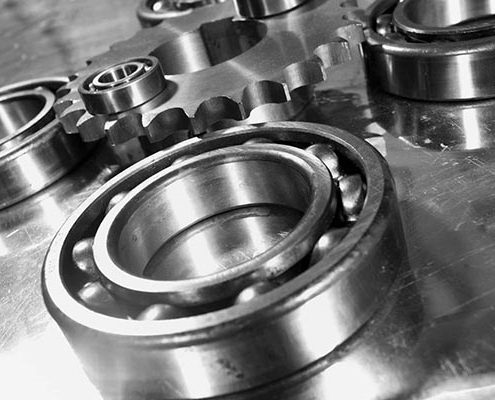Effect of steel balls on bearing performance
Abstract: The paper mainly describes all the technical criteria of steel balls on bearing vibration and noise, which play an important role in reducing bearing vibration and noise as well as improving bearing quality.
Key words: bearing vibration; property; steel balls
1 Preface

Rolling bearings should have long-life, low vibration, low noise, small rotating torque and high reliability and other basic performance. To achieve these performance, it must ensure the processing accuracy of bearing parts. Processing quality of steel balls, bearing rings and cages have effect to bearing vibraion, and the effect of steel ball processing quality is most obvious. For example: large discretization of vibration value, serious surface defects and need to avoid bumps, scratches, burns and other random quality problems. The basic problem of bearing industry is to reduce the vibration and noise of bearings which need to improve the geometric accuracy and reduce surface roughness of steel balls and bearing rings. This paper mainly describes all the technical criteria of steel balls on vibration and noise of bearing.
2 The technical criteria of steel balls on the bearing performance
The quality of steel balls directly affects the bearing performance. The technical criteria of steel balls include shape error, surface roughness and surface defects etc.
2.1 Shape error of steel balls on the bearing performance
Shape error of steel balls is one of the important reasons which affect vibration and noise of bearings. During steel ball production, steel balls keep getting in touch with the groove of grinding plate and getting constantly extrusion and friction. After consuming the excess metal of steel balls’ surface, ball blanks are finally grinded to ball shape. In order to reduce the shape error, many technical measures are carried out. The bigger shpae error of steel ball is, the bigger vibration of bearing will be. Thus, it is necessary to reduce the shape error of steel balls. Because to the exist of shape error, the center position of steel balls keep changing which causes vibration and noise of bearings. Shape error of steel balls can cause low frequency vibration of bearings.
2.2 Surface roughness of steel balls on the bearing performance
The surface roughness of steel balls usually refers to the micro-roughness except deviation from spherical form and waveness on the surface. Surface roughness of steel balls has great influence on intermediate and high frequency of bearings. It can make bearings get noises. Surface roughness of steel balls has much greater influence on bearing vibration than surface roughness of bearing rings. The bigger surface roughness of steel balls is, the greater vibration of bearings will be. Thus, surface roughness of steel balls must be reduced.
2.3 Surface defects of steel balls on the bearing performance
Surface defects refer to cracks, scratches, rust, corrosion, depression and other defects on surface caused by mechanical process, rust, corrosion or raw material. Surface defects are not allow to appear on steel ball’s surface. It is because surface defects of steel balls will cause pulse vibration and make bearings produce vibration and noises when rotating. Pulse cycle is inversely proportional to bearing rotating speed and amplitude (of vibration) is related to the size of defects. The bigger surface defects of steel balls are, the greater vibration of bearings will be.
2.4 Hardness of steel balls on the bearing performance
Hardness of steel balls directly affects fatigue life and dynamic performance of bearings. Test result shows that fatigue life is the longest when the hardnss of steel ball is approx. HRC 62; The harder the steel balls are, the better corrosion resistance is when the hardness is in the range of HRC 57 – 65; the effect is not obvious when the hardness is less than HRC 61. Hardness variation of steel balls in a same bearing set is the smaller the better. Hardness of steel balls has obvious influence of bearing vibration value. Vibration value of HRC 63 steel balls is 3 dB bigger than that of HRC 66 steel balls when they are assembled in a same bearing ring. For bearings with strict vibration requirement, it is better to keep steel ball hardness in the range of HRC 65 – 67 and the variation of hardness in a same bearing should be less than HRC 0.5.
2.5 Grinding burns of steel ball surface on the bearing performance
Grinding burns are usually produced in the grinding after quenching and tempering. Due to some unusual reason, steel balls get sudden impact, stuck, friction or grinding which rose the metal temperature of this area sharply to quenching or tempering temperature and then immediately cooling down, this will cause grinding burns on this area. Grinding burns can only be found after cold pickling. Since the microstructure and hardness of grinding burn area is different with nornal area, grinding burn area will become a potential peeling-off area and contact fatigue strength decreased significantly. The test result shows the life of burned steel balls is 16% shorter than the life of non-burn steel balls.
3 Conclusion
As rolling elements, steel ball play a role to bear and transfer load in bearing, is the key component of bearing. Improving the technical criteria of steel balls can reduce the vibration and noise of bearings, prolong the life of bearings. In our daily life, low noise bearings can reduce the noise of houshhold appliances, improve our life’s quality.
